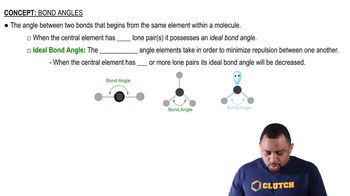Which species has the smaller bond angle, ClO4- or ClO3- ? Explain.

 Tro 6th Edition
Tro 6th Edition Ch.11 - Chemical Bonding II: Molecular Shapes, VSEPR & MO Theory
Ch.11 - Chemical Bonding II: Molecular Shapes, VSEPR & MO Theory Problem 40b
Problem 40bDetermine the molecular geometry and sketch each molecule or ion, using the bond conventions shown in “Representing Molecular Geometries on Paper” in Section 11.4. b. SCl4
 Verified step by step guidance
Verified step by step guidance
Verified video answer for a similar problem:
Key Concepts
VSEPR Theory

Molecular Geometry

Bond Angles

Determine the molecular geometry and sketch each molecule or ion using the bond conventions shown in “Representing Molecular Geometries on Paper” in Section 11.4. c. PCl5
Determine the molecular geometry and sketch each molecule or ion using the bond conventions shown in “Representing Molecular Geometries on Paper” in Section 11.4. d. BrF5
Determine the molecular geometry and sketch each molecule or ion, using the bond conventions shown in “Representing Molecular Geometries on Paper” in Section 11.4. c. ClF3
Determine the molecular geometry and sketch each molecule or ion, using the bond conventions shown in “Representing Molecular Geometries on Paper” in Section 11.4. d. IF2–
Determine the molecular geometry about each interior atom and draw each molecule. (Skeletal structure is indicated in parentheses.)
a. C2H2 (skeletal structure HCCH)
b. C2H4 (skeletal structure H2CCH2)
c. C2H6 (skeletal structure H3CCH3)